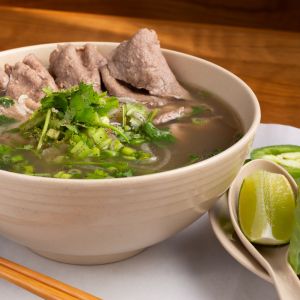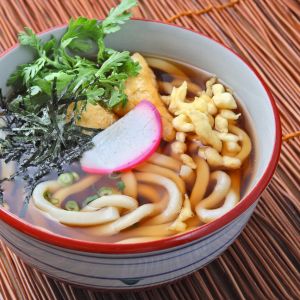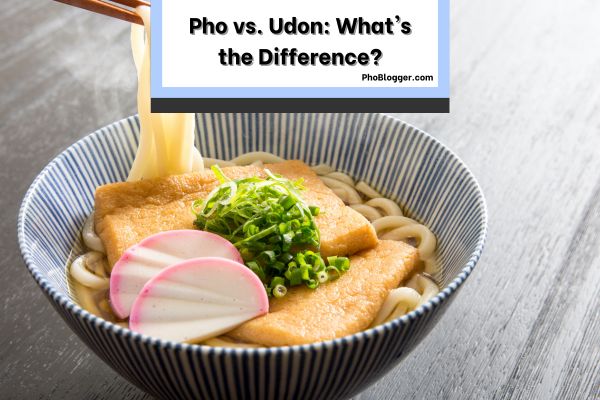What are the differences between the two noodle dishes when it comes to pho vs. udon? You’ve come to the right place if you’re curious and want to understand the differences.
When it comes to noodle dishes, there are countless variations across different cultures that have captured the hearts and appetites of food lovers around the world.
Two such dishes are pho, a Vietnamese soup, and udon, a Japanese noodle dish. While both dishes feature broth and noodles as their primary components, they differ significantly in terms of ingredients, flavor profiles, and cultural origins.
In this comprehensive guide, we will explore the differences between pho and udon, from their ingredients and preparation methods to the cultural significance of each dish.
Before you scroll down this dish comparison guide, “Pho vs. Udon: What’s the Difference,” you can check out these other pho-related articles from our team at PhoBlogger.com:
Learn About Pho

Pho is a traditional Vietnamese soup made with a rich, aromatic broth, flat rice noodles, thinly sliced meat (typically beef or chicken), and garnished with fresh herbs and vegetables.
This comforting dish is known for its complex flavors, which come from a combination of spices and aromatics that are simmered for hours to create the signature broth.
Pho is typically served with a variety of condiments and garnishes, such as lime wedges, bean sprouts, Thai basil, cilantro, and sliced chili peppers, allowing diners to customize their dish to their liking.
Key components of pho include:
- Broth: The flavorful, aromatic broth forms the foundation of the dish and is made by simmering meat or bones, spices (such as star anise, cinnamon, and cloves), and aromatic ingredients (like ginger, onion, and garlic) for several hours.
- Noodles: Pho features flat rice noodles that are soft, slightly chewy, and mild in flavor, complementing the flavors of the broth and other ingredients.
- Protein: The most common proteins found in pho are beef and chicken, though other variations may include seafood, tofu, or alternative meat substitutes.
- Herbs and garnishes: Fresh herbs, such as Thai basil, cilantro, and mint, along with bean sprouts, lime wedges, and sliced chili peppers, are often served with pho, allowing diners to customize their dish with additional flavors and textures.
Learn About Udon

Udon is a popular Japanese noodle dish featuring thick, chewy wheat noodles served in a savory broth. The broth, known as dashi, is made from simmered ingredients like bonito flakes, dried kelp, and sometimes dried sardines, creating a delicate umami flavor.
Udon can be enjoyed both hot and cold, and the dish often includes various toppings, such as tempura, thinly sliced meat, vegetables, or fish cakes.
Key components of udon include:
- Broth: The savory broth, or dashi, is made by simmering ingredients such as bonito flakes, dried kelp, and sometimes dried sardines, resulting in a delicate umami flavor that serves as the base for the dish.
- Noodles: Udon noodles are made from wheat flour, water, and salt, resulting in thick, chewy noodles that are the star of the dish.
- Toppings: Udon is typically served with a variety of toppings, including tempura, thinly sliced meat, vegetables, and fish cakes, which add flavor and texture to the dish.
- Condiments: Udon is often accompanied by condiments like soy sauce, grated ginger, and chopped green onions, allowing diners to customize their dish to their preferences.
Pho vs. Udon: The Differences
Now that we have a basic understanding of each dish let’s delve into the differences between pho and udon:
- Cultural origins: Pho is a traditional Vietnamese dish, while udon is of Japanese origin. Each dish reflects the unique flavors and culinary techniques of its respective culture.
- Broth: Pho broth is known for its rich, aromatic flavors, derived from simmering meat or bones, spices, and aromatic ingredients for several hours. In contrast, udon’s broth, or dashi, has a more delicate and subtle umami flavor, resulting from simmering ingredients like bonito flakes, dried kelp, and sometimes dried sardines.
- Noodles: The noodles used in pho and udon are distinct in terms of composition and texture. Pho features flat rice noodles, which are soft, slightly chewy, and mild in flavor, while udon noodles are made from wheat flour, water, and salt, creating thick, chewy noodles with a more robust texture.
- Proteins: Pho is commonly served with thinly sliced beef or chicken, while udon’s toppings may include tempura, thinly sliced meat, vegetables, or fish cakes. The choice of protein in each dish reflects the culinary traditions of their respective cultures.
- Herbs, garnishes, and condiments: Pho is often accompanied by a variety of fresh herbs, such as Thai basil, cilantro, and mint, as well as bean sprouts, lime wedges, and sliced chili peppers, which allow diners to customize their dish. Udon, on the other hand, is typically served with condiments like soy sauce, grated ginger, and chopped green onions, as well as a variety of toppings that add flavor and texture to the dish.
- Serving style: Pho is generally served as a hot soup, while udon can be enjoyed both hot and cold. Hot udon dishes often feature a savory broth, while cold udon dishes are typically served with a dipping sauce, such as tsuyu, made from soy sauce, mirin, and dashi.
- Vegetarian and vegan options: Both pho and udon can be adapted to suit vegetarian and vegan diets. Vegetarian pho can be made using vegetable-based broth and toppings like tofu or vegetables. Similarly, vegetarian udon can be prepared with kombu (kelp) dashi and plant-based toppings. However, it is essential to note that some udon broths may contain fish-based ingredients like bonito flakes, so it is crucial to inquire about the ingredients when dining out or purchasing pre-made broths.
Conclusion For “Pho vs. Udon: What’s the Difference”
Pho and udon are both delicious and comforting noodle dishes that hail from different culinary traditions: pho from Vietnam and udon from Japan. While they share some similarities, such as featuring broth and noodles as their primary components, they differ significantly in terms of ingredients, flavor profiles, and cultural significance.
Pho is characterized by its rich, aromatic broth, flat rice noodles, and thinly sliced meat, accompanied by a variety of fresh herbs and garnishes. Udon, on the other hand, features thick, chewy wheat noodles served in a delicate, umami-rich dashi broth, often topped with tempura, meat, vegetables, or fish cakes.
By understanding the differences between these two beloved dishes, you can appreciate the unique flavors and culinary techniques of each and expand your palate by exploring the diverse world of noodle dishes. We hope this comparison between pho vs. udon helped you.
If you find this noodle soup comparison guide, “Pho vs. Udon: What’s the Difference,” helpful/informative, you can check out these other related content from our team:
- Ideas on What to Do With Leftover Pho Broth
- Does Pho Have Eggs as an Ingredient?
- Does Pho Have Sesame?
Now that you have a better understanding between pho and udon, you can learn more about these dishes by watching “Beef Noodle Soup vs. Ramen vs. Udon vs. Pho, Noodle Battle” from Food Battles down below:

